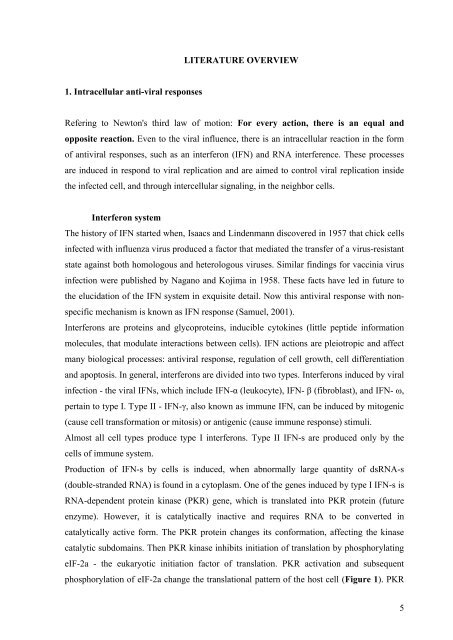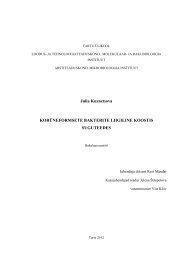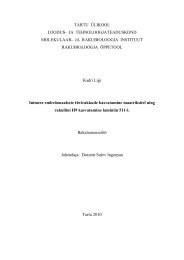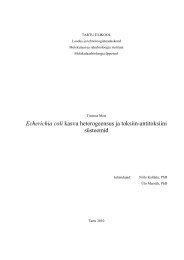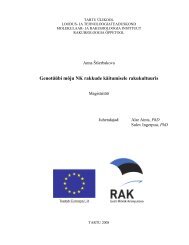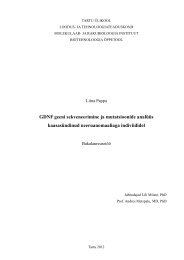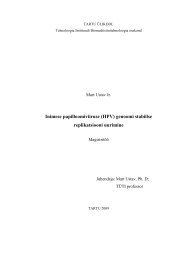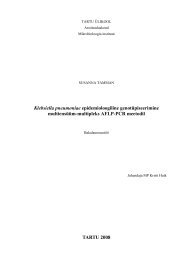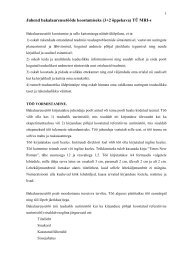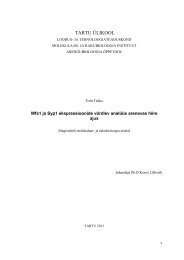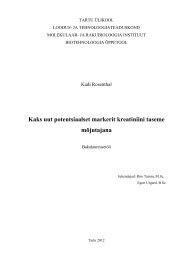Viruses and RNA interference in mammalian cells
Viruses and RNA interference in mammalian cells
Viruses and RNA interference in mammalian cells
You also want an ePaper? Increase the reach of your titles
YUMPU automatically turns print PDFs into web optimized ePapers that Google loves.
LITERATURE OVERVIEW<br />
1. Intracellular anti-viral responses<br />
Refer<strong>in</strong>g to Newton's third law of motion: For every action, there is an equal <strong>and</strong><br />
opposite reaction. Even to the viral <strong>in</strong>fluence, there is an <strong>in</strong>tracellular reaction <strong>in</strong> the form<br />
of antiviral responses, such as an <strong>in</strong>terferon (IFN) <strong>and</strong> <strong>RNA</strong> <strong><strong>in</strong>terference</strong>. These processes<br />
are <strong>in</strong>duced <strong>in</strong> respond to viral replication <strong>and</strong> are aimed to control viral replication <strong>in</strong>side<br />
the <strong>in</strong>fected cell, <strong>and</strong> through <strong>in</strong>tercellular signal<strong>in</strong>g, <strong>in</strong> the neighbor <strong>cells</strong>.<br />
Interferon system<br />
The history of IFN started when, Isaacs <strong>and</strong> L<strong>in</strong>denmann discovered <strong>in</strong> 1957 that chick <strong>cells</strong><br />
<strong>in</strong>fected with <strong>in</strong>fluenza virus produced a factor that mediated the transfer of a virus-resistant<br />
state aga<strong>in</strong>st both homologous <strong>and</strong> heterologous viruses. Similar f<strong>in</strong>d<strong>in</strong>gs for vacc<strong>in</strong>ia virus<br />
<strong>in</strong>fection were published by Nagano <strong>and</strong> Kojima <strong>in</strong> 1958. These facts have led <strong>in</strong> future to<br />
the elucidation of the IFN system <strong>in</strong> exquisite detail. Now this antiviral response with nonspecific<br />
mechanism is known as IFN response (Samuel, 2001).<br />
Interferons are prote<strong>in</strong>s <strong>and</strong> glycoprote<strong>in</strong>s, <strong>in</strong>ducible cytok<strong>in</strong>es (little peptide <strong>in</strong>formation<br />
molecules, that modulate <strong>in</strong>teractions between <strong>cells</strong>). IFN actions are pleiotropic <strong>and</strong> affect<br />
many biological processes: antiviral response, regulation of cell growth, cell differentiation<br />
<strong>and</strong> apoptosis. In general, <strong>in</strong>terferons are divided <strong>in</strong>to two types. Interferons <strong>in</strong>duced by viral<br />
<strong>in</strong>fection - the viral IFNs, which <strong>in</strong>clude IFN-α (leukocyte), IFN- β (fibroblast), <strong>and</strong> IFN- ω,<br />
perta<strong>in</strong> to type I. Type II - IFN-γ, also known as immune IFN, can be <strong>in</strong>duced by mitogenic<br />
(cause cell transformation or mitosis) or antigenic (cause immune response) stimuli.<br />
Almost all cell types produce type I <strong>in</strong>terferons. Type II IFN-s are produced only by the<br />
<strong>cells</strong> of immune system.<br />
Production of IFN-s by <strong>cells</strong> is <strong>in</strong>duced, when abnormally large quantity of ds<strong>RNA</strong>-s<br />
(double-str<strong>and</strong>ed <strong>RNA</strong>) is found <strong>in</strong> a cytoplasm. One of the genes <strong>in</strong>duced by type I IFN-s is<br />
<strong>RNA</strong>-dependent prote<strong>in</strong> k<strong>in</strong>ase (PKR) gene, which is translated <strong>in</strong>to PKR prote<strong>in</strong> (future<br />
enzyme). However, it is catalytically <strong>in</strong>active <strong>and</strong> requires <strong>RNA</strong> to be converted <strong>in</strong><br />
catalytically active form. The PKR prote<strong>in</strong> changes its conformation, affect<strong>in</strong>g the k<strong>in</strong>ase<br />
catalytic subdoma<strong>in</strong>s. Then PKR k<strong>in</strong>ase <strong>in</strong>hibits <strong>in</strong>itiation of translation by phosphorylat<strong>in</strong>g<br />
eIF-2a - the eukaryotic <strong>in</strong>itiation factor of translation. PKR activation <strong>and</strong> subsequent<br />
phosphorylation of eIF-2a change the translational pattern of the host cell (Figure 1). PKR<br />
5


